

Southern Shaolin Monastery. The Southern Shaolin Monastery is the name of a Buddhist monastery whose existence and location are both disputed.
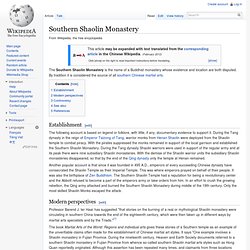
By tradition it is considered the source of all southern Chinese martial arts. Establishment[edit] Shaolin Monastery. Shaolin Monastery or Shaolin Temple (Chinese: 少林寺; pinyin: Shàolín Sì; Wade–Giles: Shao4-lin2 Szu4, pronounced [ʂɑ̂ʊ̯lǐn sî]; Cantonese Yale: Siulàhm Jí) is a Chán Buddhist temple on Mount Song, near Dengfeng, Zhengzhou, Henan province, China. Taiping Institute - Huzun Quan : 太平武馆 - 虎尊拳. White Lotus Rebellion of the Qing Dynasty. Brief History. Thirty Six battles-third of the main kata of Uechi Ryu.
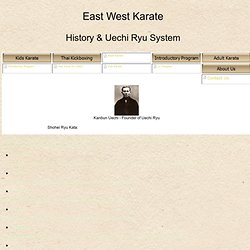
*In addition, there is speculation that there was another kata in the system as taught by Cho Tzu HO-Suparimpei (108 movements or battles). Kanbun elected not to teach this kata. It has been said that he either felt that it was simply not needed for the system or that he had not mastered it to the point where he was willing to pass it on. Kanbun legends. From one of the articles linked: <BLOCKQUOTE><font size="1" face="Verdana, Arial">quote Quote: The rumor continues stating that Kanbun then entered the Kojo dojo at Fuchou but due to a speech impediment, the dojo's Chief Assistant Makabe Udon took him for a fool and nicknamed him Uechi Watabugwa (meaning big belly or good for nothing).

Offended by these insults, Kanbun left the dojo and was not seen for three years. Not sure this is entirely correct. <BLOCKQUOTE><font size="1" face="Verdana, Arial">quote:</font><HR>Kanbun Sensei did the same type of breathing. ** This also goes to the original way of breathing as taught by Kanbun [ breathing with motion, as opposed to the breathing after the thrust we are led to believe] <BLOCKQUOTE><font size="1" face="Verdana, Arial">quote:</font><HR> He spoke seldom during training sessions, but after the day was done hewould speak quite eloquently.
Uechi-ryu Karate A short History: Part 1. By Mario McKenna Editor’s Note: Uechi Ryu Karate is a powerful, hard Okinawan style, which originated in China.

It was brought to Okinawa early in this century by Kanbun Uechi and shares many similarities with Goju Ryu karate and the lesser Naha-Te styles of To'on Ryu and Ryuei Ryu. Uechi Ryu is characterized by upright stances, circular blocks, grabs, open hand and one knuckle techniques plus low kicking, often using the big toe. Uechi-ryu Karate A short History: Part 2. By Mario McKenna Editor’s Note: This is the second article in the history of Naha-Te (meaning Naha-hand, Naha referring to the seaport city in Okinawa) Uechi-Ryu karate.
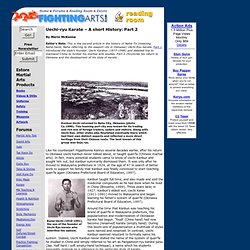
Part 1 introduced the style’s founder, Uechi Kanbun (1877-1948) and detailed trip to mainland China to further his martial arts studies. Factors leading to Uechi-Ryu Development. Introduction You will see footnotes scattered throughout this document.

Kanbun's years in China. That their husbands and sons would be unfit for military service.

Therefore, encouraged byhis elders, Kanbun quietly left in the middle of March 1897 for .[23] Kanbun's father warned him that life would be far from easy in . Success, he told Kanbun, would depend upon maintaining a level of self- discipline as yet unknown to him. Kanbun was nineteen years old. and , the only way from to was to be smuggled out. Kanbun, embarking quietly from Kadena, paid ten yen to join a group of young Okinawans boarding a ship bound west to ...and a new life. . , same school, late marriage and finding employment as spinning company employees in .[27] Matsuda is remembered for his skill with the Chinese Halberd.[28] The Kugusuku school was run by a Chinese teacher named Kaho Kojo (1849 - 1925).
The return to Okinawa. Kanbun's return to , Mr.
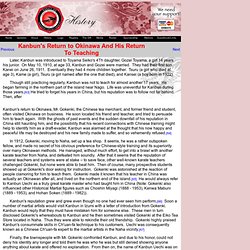
Gokenki, the Chinese tea merchant, and former friend and student, often visited on business. He soon located his friend and teacher, and tried to persuade him to teach again. With the ghosts of past events and the sudden downfall of his reputation in still haunting him, and the possibility that his recent connections with Chinese training might help to identify him as a draft-evader, Kanbun was alarmed at the thought that his now happy and peaceful life may be destroyed and his new family made to suffer, and so vehemently refused.[64] , set up a tea shop.
It seems, he was a rather outspoken fellow, and made no secret of his obvious preference for Chinese-style training and its superiority over many Okinawan methods. . . , the Motobu police department held a large celebration. Formal Dojo formation. 3.

The associations goals are the following principles: SHATAKU DOJO PRACTITIONERS April 1926 - March 1932 TEBIRA DOJO PRACTITIONERS Pan-gai-nun-ryu Karate-jutsu Institute Period For a short period after their marriage Mr. and Mrs. Modernization of Uechi-Ryu. Hand and foot techniques.
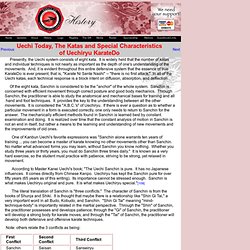
It provides the key to the understanding between all the other movements. It is considered the "A.B.C.' Bibliography. Five Elders. In Southern Chinese folklore, the Five Elders of Shaolin (Chinese: 少林五祖; Mandarin Pinyin: Shàolín wǔ zǔ; Jyutping: Siu3 lam4 ng5 zou2) are the survivors of one of the destructions of the Shaolin temple by LianZong Wang Qing Dynasty, variously said to have taken place in 1647, in 1674 or in 1732. The original Shaolin Monastery was built on the north side of Shaoshi Mountain, the central peak of Mount Song, one of the Sacred Mountains of China, located in the Henan Province, by Emperor Xiaowen of the Northern Wei Dynasty in 477.
At various times throughout history, the monastery has been destroyed (burned down) for political reasons, and rebuilt many times.[1] It is said that five Shaolin temples existed in various locations throughout Chinese history, although all 5 were rarely active at the same time.[2][3] The Five Elders of Shaolin[edit] Within many martial arts circles, these original Five Elders of Shaolin are said to be The Five Family Elders[edit] See also[edit] References[edit] Tiger Crane Kung Fu Application.
Boxer Rebellion. This is a historical article from an early issue of China Now magazine. The Boxer Rebellion has long been seen as one of the first indication of Chinese Nationalism after the humiliation of the Opium Wars. An outbreak of mindless, xenophobic violence or a heroic anti-imperialist struggle which is 'the pride and glory of the Chinese people and one of the foundation stones for their triumph fifty years later'? One's attitude towards the Boxer Movement is regarded in China today as a 'touchstone distinguishing genuine from fake revolutionaries, revolutionaries from counter-revolutionaries.' Peter Fleming in his book on the Boxers, wrote that, they [the foreigners] came to China to trade; their motives may not have been lofty, but it was natural and legitimate… It was inevitable that the Powers would come with selfish aims to China.
It was inevitable that they would be prepared to use force to further their aims. Triad (underground society) History « Shaolin KungFu Brighton. A History of our Arts The origin of Shaolin Kung Fu is generally credited to an Indian monk named Tat Moh, who is also sometimes known as Bodhidharma. He began life as a prince in Southern India, but became a devoted Buddhist, renouncing his royal heritage to take up the simple lifestyle of a monk. He traveled widely, spreading the teachings of Buddhism.
Eventually he rose to become the 28th patriarch of India. Shaolin Martial Arts: Nam Yang Kung Fu.